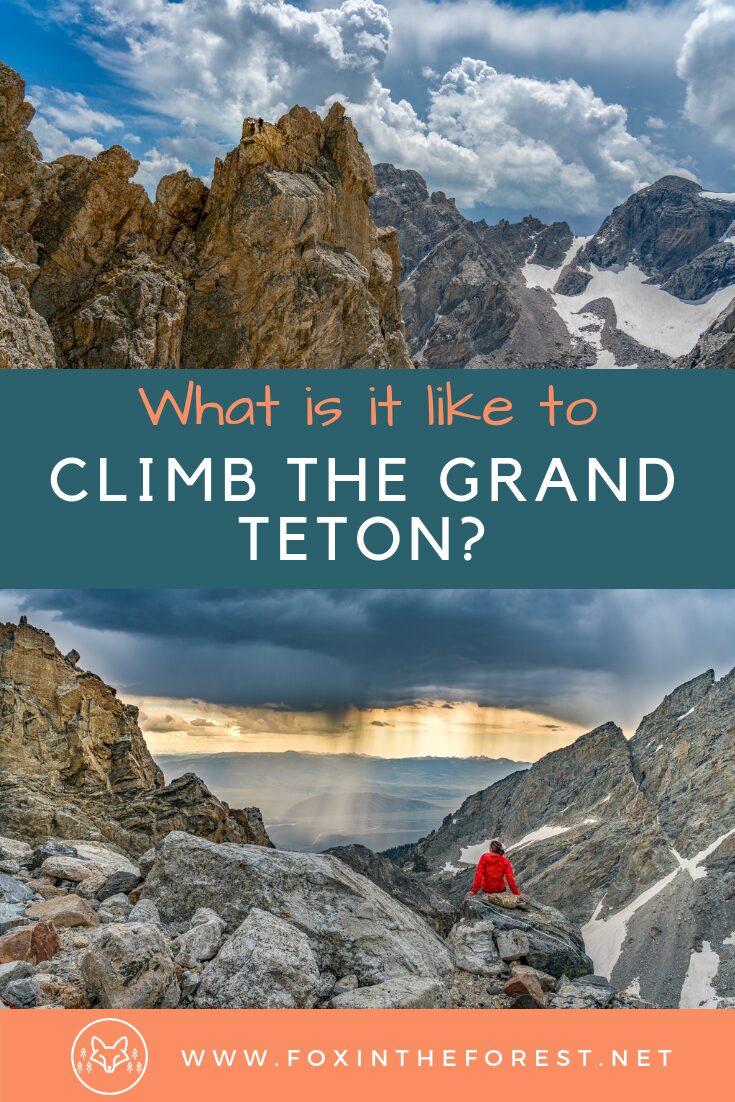Last Updated on December 20, 2023 by foxintheforest
When I was asked by Big City Mountaineers to join them as working media on their Summit for Someone trip up the Grand Teton, I couldn’t say no. I had been looking to break into high-alpine roped climbing and the Grand Teton felt like the perfect introduction. Little did I know that the trip would be a life-altering experience, shifting my perspective on my mountain career.
Jackson Hole Mountain Guides led the trip up to the top. It was my first time going on a guided climb, and to be honest, I wasn’t too sure what to expect.
Jackson Hole Mountain Guides provided the team with everything they needed and then some. Here’s an in-depth look at what it’s like going on a guided climb of the Grand Teton and why the folks at Jackson Hole Mountain Guides are the go-to guides for this signature trip.
**NOTE: This trip was done in conjunction with both Big City Mountaineers and Jackson Hole Mountain Guides. While on the climb, I was working for both Big City Mountaineers and Jackson Hole Mountain Guides (photography and writing work). Although the cost of my trip was covered by the organizations, they did not require me to write a review. This account accurately reflects my experiences with them and was done because I believe in the service they provide. As always, all opinions are my own.
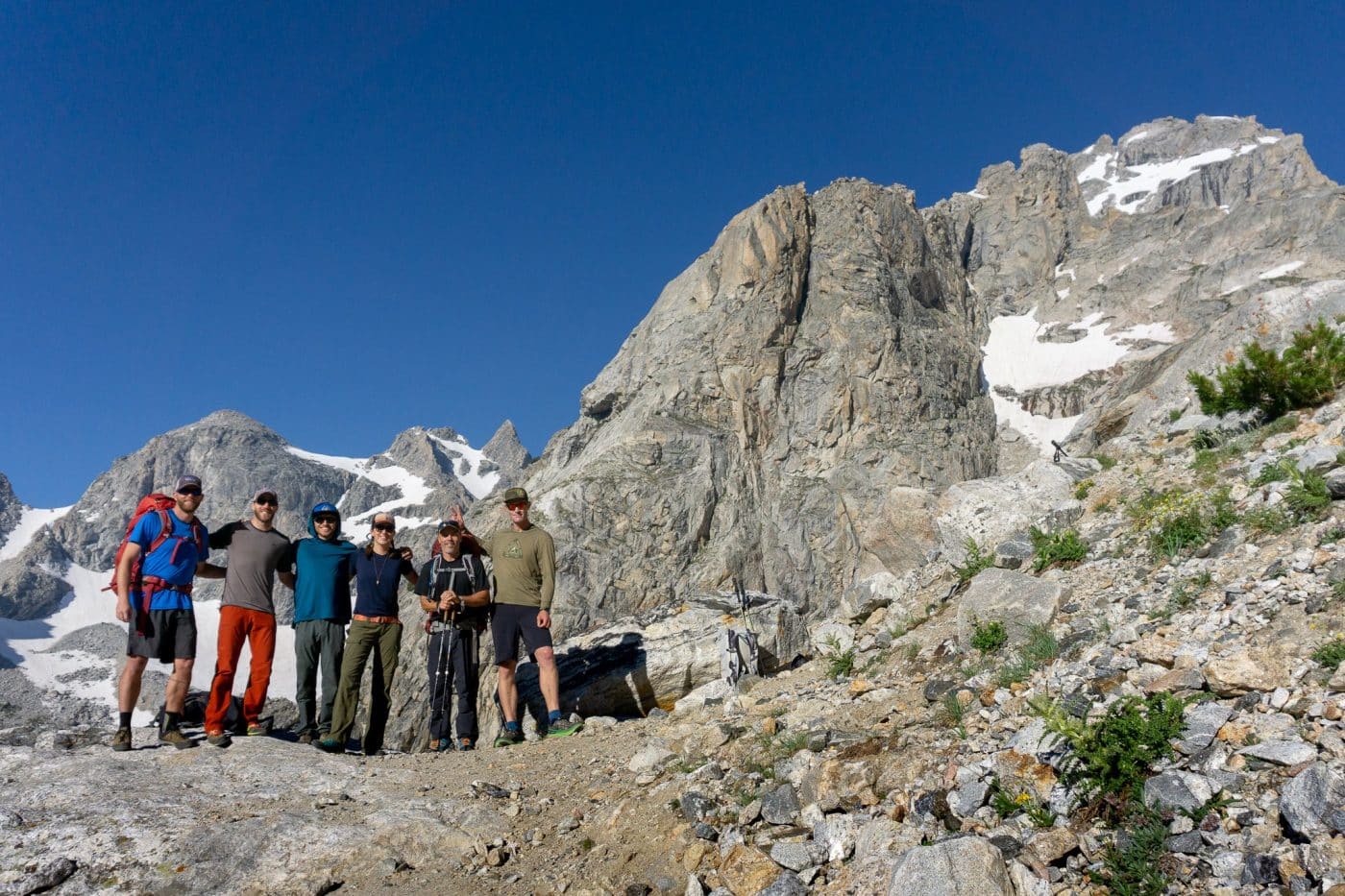
National Parks Around Jackson, Wyoming
Jackson, Wyoming is not only an iconic old western town, but it is the premier hub for both Grand Teton National Park and Yellowstone National Park. Your journey to the summit of the Grand Teton will most likely begin and end here.
The Iconic Climb of the Grand Teton
The Grand Teton stands 13,776 feet tall, towering approximately 7,000 vertical feet above the valley floor. This iconic climb requires ropes, no matter which route you take. That means that even the standard or easiest routes contain vertical, fifth-class climbing.
Due to our team’s experience, we did the Pawnall-Gilkey route. This particular route deviates slightly from the classic Exum route and contains three roped pitches of climbing. One 5-easy across a highly exposed slab, a 5.8 crux pitch nestled in a dihedral and a 5.6 straight-forward climb.
The route joins the Exum in several spots and includes plenty of highly-exposed class 3 and 4 scrambling. In essence, it’s a technical climb that not only requires skill and endurance, but a pretty solid head game to deal with the steep drops and airy ascent.
Most climbers downclimb the Owen-Spaulding route. This route has the added spice of a 40m rappel, which quickly makes its way over a ledge for a long, free-hanging descent. Oh, the glory of the high alpine!
New to mountain climbing? Here’s everything you need to get started:
- Tips for climbing your first mountain
- The complete crash course to roped climbing outdoors
- Get over your fear of heights
- Tips for acclimatizing to high altitude safely
My Climbing Experience
Over the years, I’ve somehow gone from being an exposure weenie to a diehard scrambler. I regularly climb exposed peaks without a rope in the Class 3 and 4 range. Since I live and train at altitude, I really didn’t do too much training to prepare for this climb, aside from what I normally do anyway.
In terms of climbing, I’ve been a rock climber for nearly four years. Remember how I said I have an intense fear of heights? Well, that means my climbing career has been slow to progress. However, I can comfortably lead sport routes in the 5.10-minus range.
The Grand Teton was the first time I chose to combine my love of scrambling with my affinity for roped climbing. It turns out, I discovered a new passion to pursue.
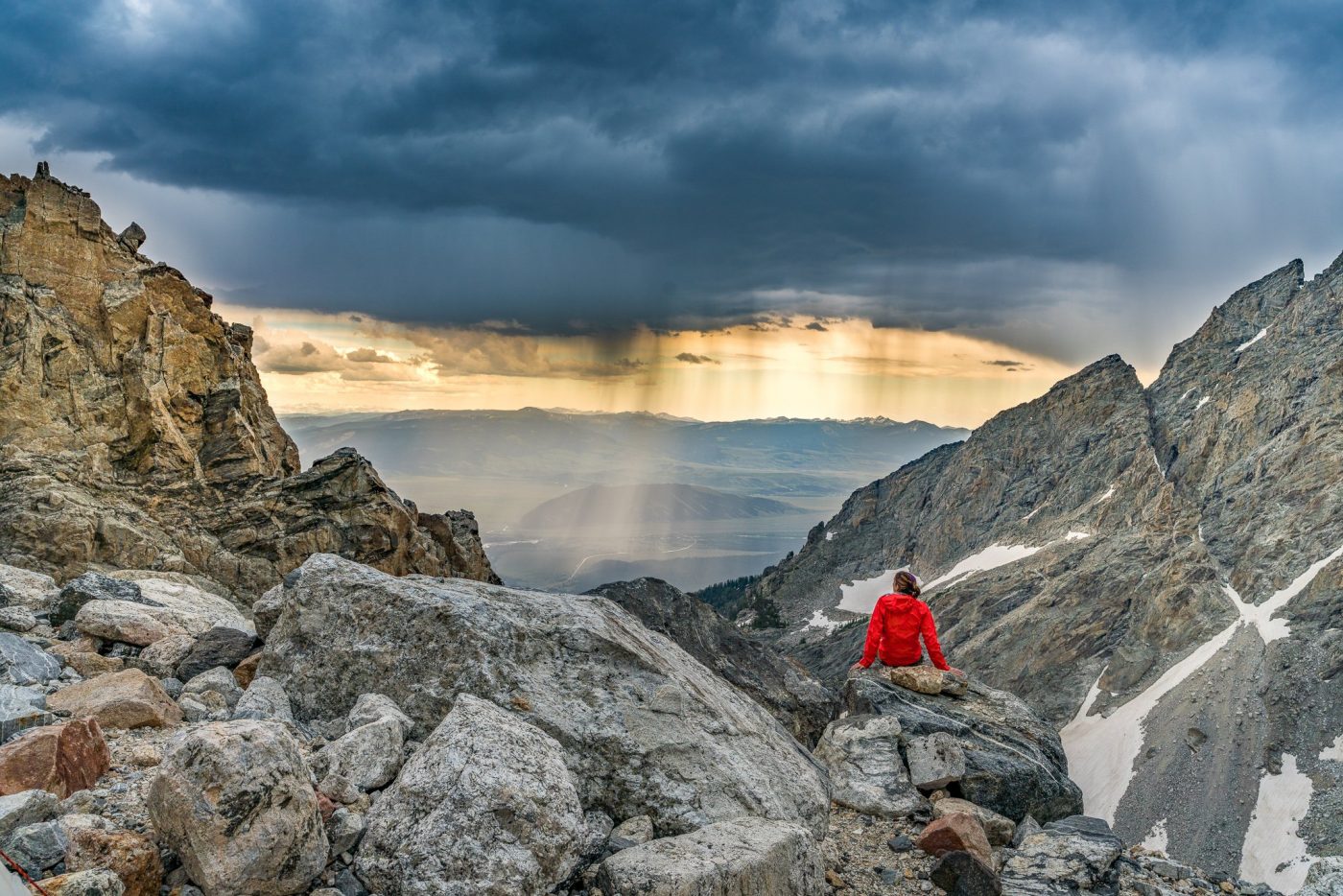
The Four-Day Climbing Trip with Jackson Hole Mountain Guides
When I arrived at the Lupine Meadows Trailhead on the first day of the climb, I had to admit, I was pretty nervous. Leading up to the day we left, I had been battling an IT-band injury in my knee. I was nervous that I wouldn’t be able to climb. To make matters worse, I was the only one in the group who didn’t know anyone (and the only female).
My fears quickly melted away as I strapped on my 38lb pound pack (professional camera gear is heavy folks) and started up the trail. The team came from all over the United States and I quickly became chatty with the guides and other team members.
Since several team members hail from places at low altitude, the guides kept an easy-going pace for acclimatization. As a fellow high-altitude dweller, I found the hike to high camp to be pretty painless.
However, one of our team members struggled with past injuries and it soon became clear that he would be unable to make it to high camp. Both guides pulled our fellow team member aside and he chose to descend with another group that was coming down from high camp.
Overall, it was a safe call to make, albeit difficult. It made me think of my knee, which was surprisingly not giving me any trouble. The way the guides handled the situation was realistic and professional, but not pushy.
Life at Corbet High Camp
After the 4,000-foot ascent over 6.9 miles of stunning trail, we reached Corbet High Camp. Photographs truly don’t do this place justice. Located right next to a stunning glacier and plenty of dramatic rock, Corben High Camp feels like a cozy home in the high alpine.
When I first learned we wouldn’t be carrying our pro, sleeping bags, pads, and tents to high camp, I thought, is this actually mountain climbing? After carrying nearly 40 pounds of gear up to camp, I can safely say that yes, you are still climbing the mountain.
Part of being with a guiding service is the camps they provide for you. Corbet High Camp had ample room for us to roam, safe drinking water, a communal tent for everyone to gather (and stand in) when the weather turned to crap, and a rocky playground filled with fantastic climbing. Never once did I feel like I wasn’t truly climbing, but guided climbing is a different kind of climbing.
About an hour after our camp orientation, the weather turned. As we watched the storm break over the valley, and eventually drive us to the safety of the communal tent, I thought about how lucky I was to spend the next three nights here.
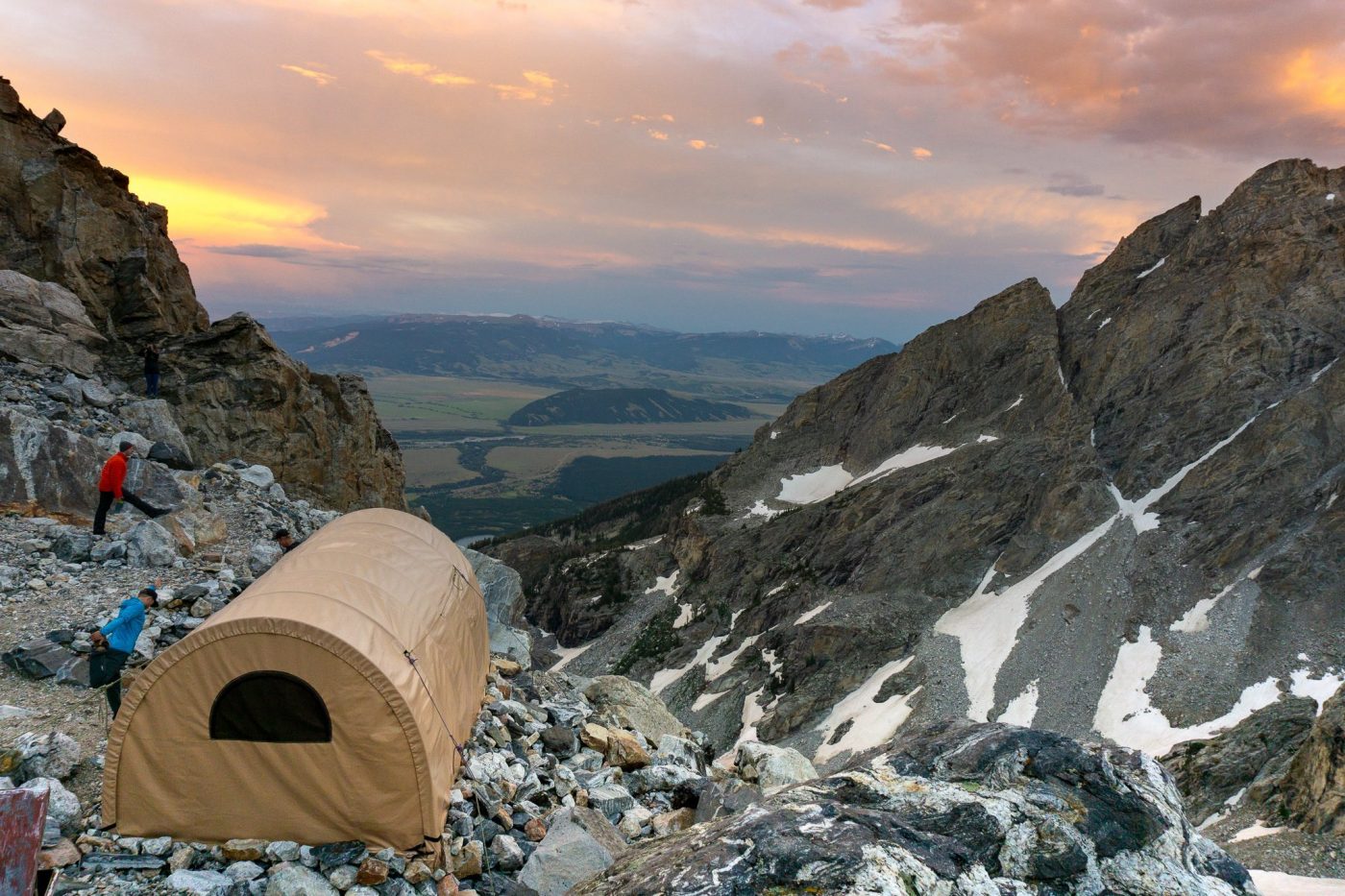
Training for High Alpine Climbing with Jackson Hole Mountain Guides
The following day, Jackson Hole Mountain Guides dedicates an entire day to training and climbing in the nearby cirque. At first, I was particularly keen on learning everything I could about multi-pitch climbing and trad climbing. These two items were the next steps in my climbing career. However, I found that I picked up quite a few tidbits about my climbing technique too.
You learn how to trust your feet and work your way down slabby scrambles without using your hands. I found the techniques here valuable since I’m largely self-taught when it comes to scrambling. We then moved from low-consequence boulders around camp to actual pitches of rock. We practiced the following techniques on real-world terrain. It. Was. AWESOME!
- Multi-pitch following
- Cleaning a trad route
- Commands and responses
- Moving in a team of three
- Scrambling and downclimbing
- Moving as a short-roped team
- Rappelling using a fireman’s belay
A Note About Short Roping
If you’ve ever climbed a class 3 or 4 mountain on your own, chances are you weren’t short-ropped. This is when someone belays you from his or her hip and you move with another climbing partner at the same time.
It’s actually a bit tough if you’re used to moving at your own pace and in your own way. To be honest with you, I really didn’t like it. It threw off my head game, making simple scrambling areas feel more dangerous than they actually were.
However, with that being said, I see why guiding services short-rope clients. It’s a liability issue and it is certainly justified. It would be unfair for me to be upset with the use of short roping on this route since any and every guide service is going to do it. It’s simply a matter of a self-guided climb compared to a guided one.
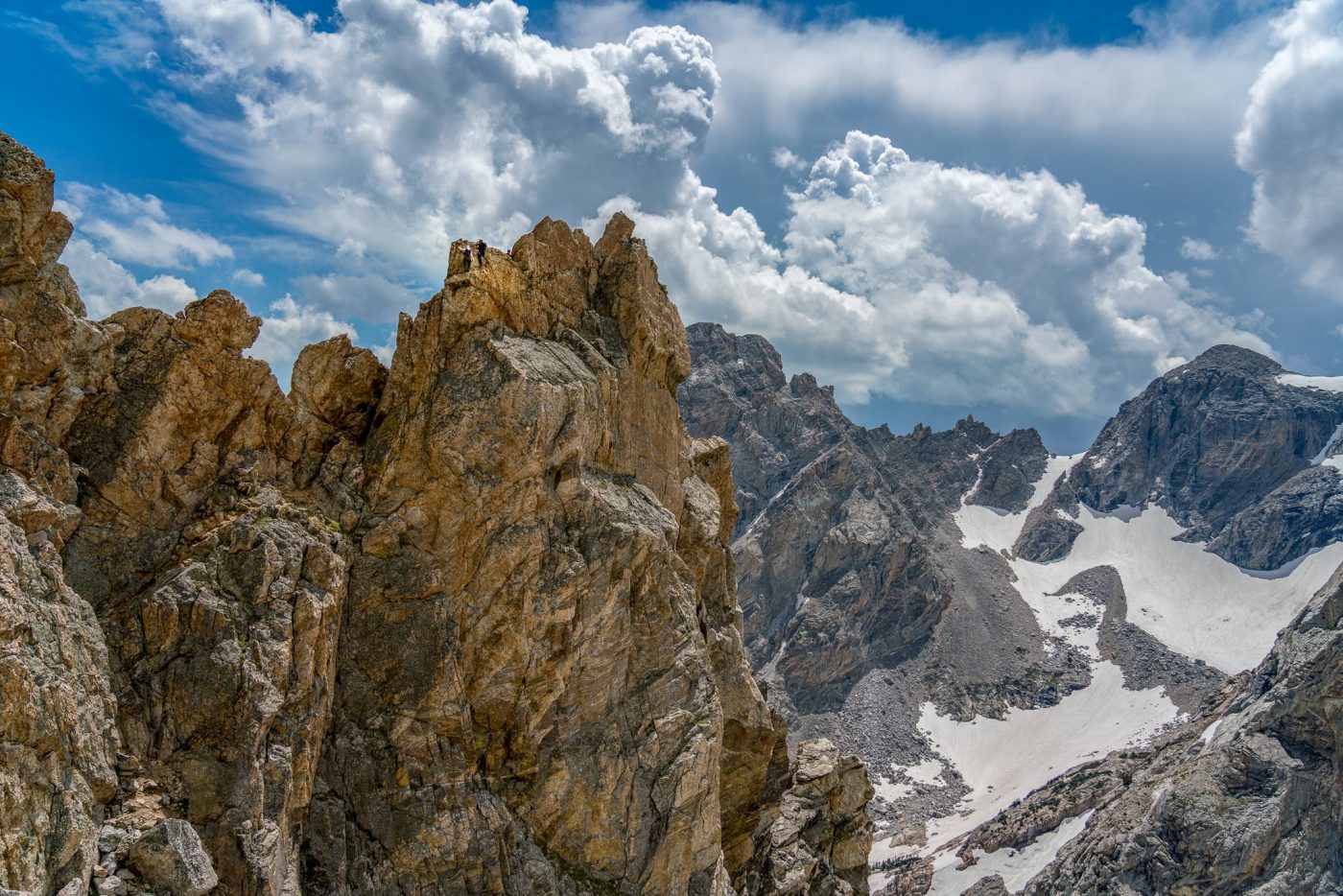
Summiting the Grand Teton via the Pownall-Gilkey Route
Since our team consisted of strong climbers, we opted for the later 3:30 am start. The mountain gods must have headed our call, as the weather looked to be crystal clear all day with little wind. We set out with our headlamps guiding us up to the summit saddle.
Together we worked our way through fixed lines and pebble hopping. Once we reached the upper saddle, the day greeted us with stunner alpenglow and the show continued until we reached our second rock pitch. So far the team felt confident and chipper. Then we hit the crux, that 5.8 pitch I mentioned at the beginning of this post.
It was covered in a thin layer of ice and made for extremely difficult climbing. I was the first of the clients to send the pitch and before I knew it my hands were frozen. It took every ounce of effort for me to find a small toehold that wasn’t slathered in ice and work my way through it.
As I slowly climbed with my numb stump-arms I let out guttural screams. My teammates cheered me on as I whooped painfully up the pitch. Despite the unexpected icy challenge, I felt totally secure and safe the entire time. I knew that the guides were highly qualified and believed in my ability to send the pitch.
Once we broke out into our roped teams, our guide Collin, Rob, and I made quick work of the rest of the summit. We worked well as a team and Collin always gave solid beta to follow. Once the entire group made it to the top, we celebrated with some silly photos and a well-earned snack.
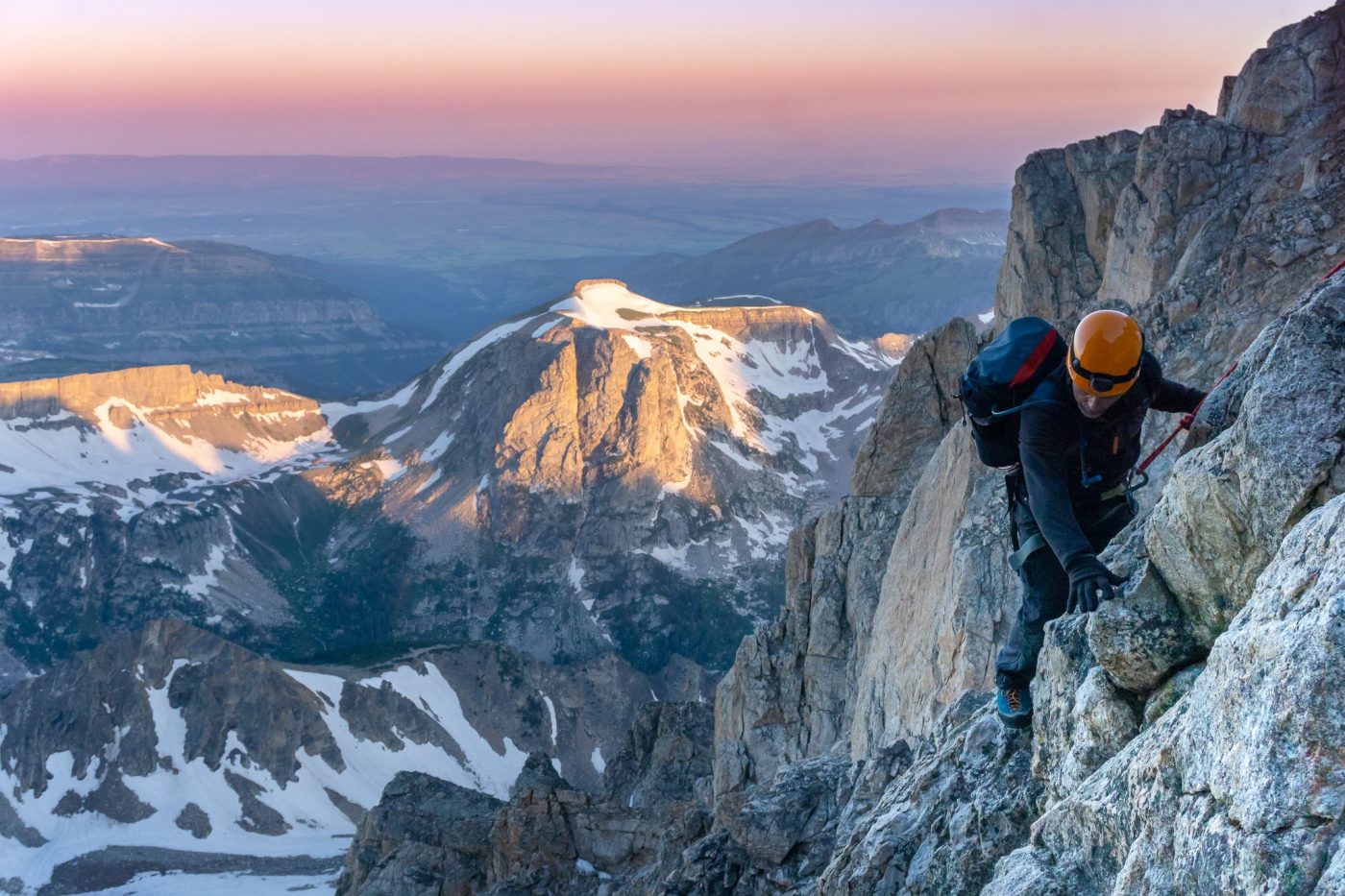
Final Thoughts about Summiting the Grand Teton with Jackson Hole Mountain Guides
Overall I found the quality of the guides to be super-knowledgable. They were professional, yet personable. You felt like you were more than just a client. Your experience, thoughts, and personal goals mattered. Our team worked hard and we were all out there for different reasons, yet shared the same amazing goal of summiting a mountain in order to send the younger generations on a wilderness experience.
What Kind of Experience Do You Need to Climb the Grand Teton with a Guide?
Don’t let the lower elevation fool you, this is not an easy climb. Not only is it extremely physical, but it’s steep, exposed and requires you to remain calm as you cross over sections with hundreds, if not thousands of feet of drops below you. Remember, you have to convince yourself to drop off of a 40m rappel (140+ feet) and hang off of a 90-foot cliff, dangling by a rope.
I would recommend being comfortable on a roped system, understanding the basics of climbing and be able to lead belay. Even though we received training, there was a fair amount of assumed knowledge (belaying being one of them). Have a few rappels and plenty of scrambling and climbing under your belt before tackling this challenge.
What Kind of Shape Should I Be in?
The Grand Teton involves over 7,000 vertical feet of gain. Summit day is approximately three miles round-trip and contains 3,000 feet of gain. That’s quite a bit of vertical in a day. It took us nine hours door-to-door. Be comfortable carrying weight up steep slopes. Also, be sure that you are able to be out for long durations. Remember: the summit is only the halfway point.
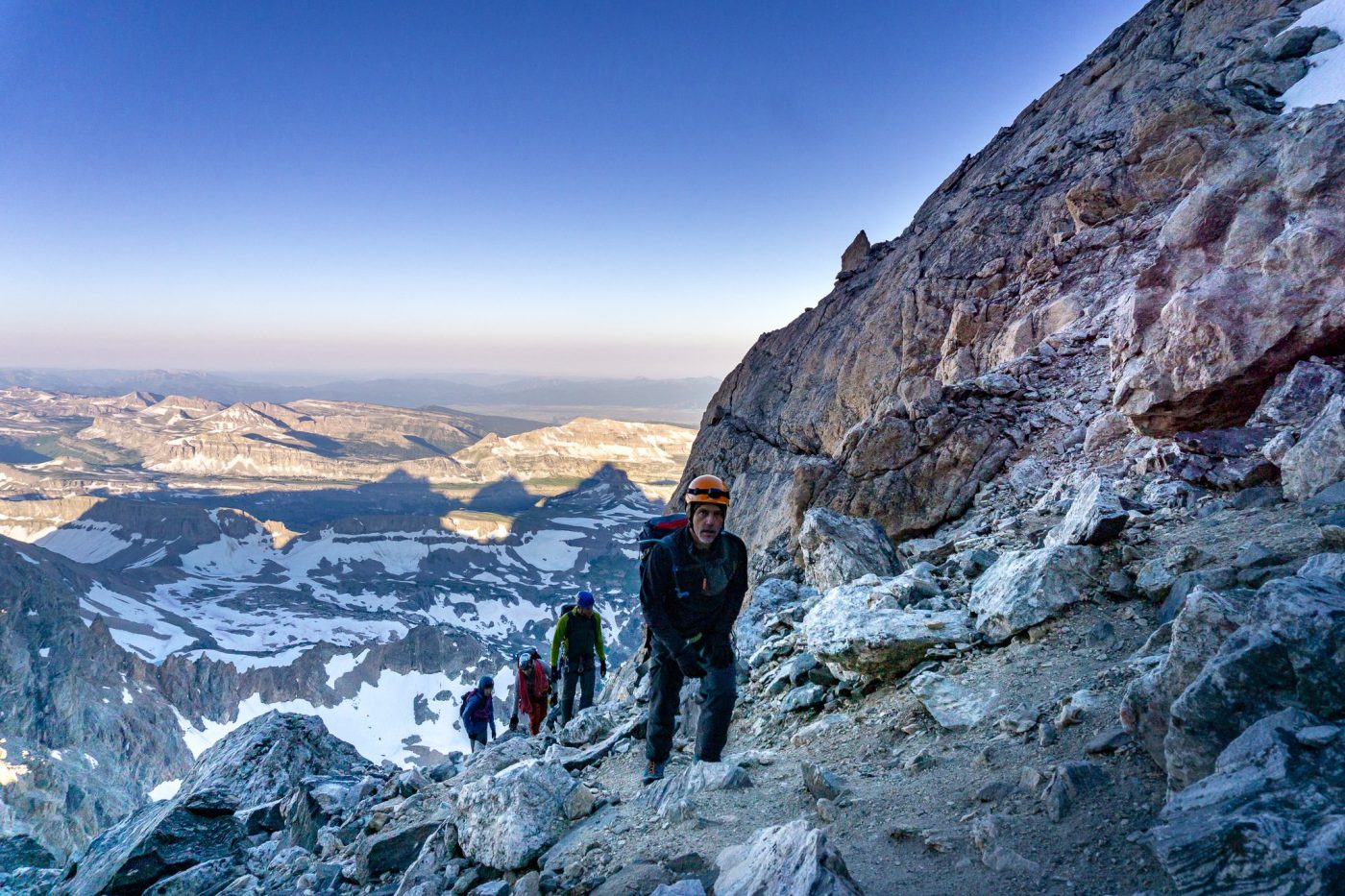
Do I Need Any Special Gear to Climb the Grand Teton?
Jackson Hole Mountain Guides provided us all with helmets, ropes, summit packs, protection/climbing gear, dinners and breakfasts (and plenty of snacks), four-season tents, sleeping bags, and restroom bags. Aside from proper mountain clothing and footwear, you really only needed to bring your lunch and any personal snacks.
Food consists of pre-made, vacuum-sealed meals. This added a bit of weight to our packs, but food is always heavy and it sure beat the hell out of the dehydrated meals I’m used to when I mountaineer at home.
What Did Jackson Hole Mountain Guides Do the Best?
Accommodate you. Since I was there for photography work, I had a different set of needs than the rest of the group. Both the office and the guides were extremely helpful in getting me what I needed to do my job. Collin, the lead guide on our trip, made sure to alert me of good photo opportunities and remind me when it was time to make time and pick up the pace.
He took extremely good care of me when I topped out on the crux with hands completely numb from the wrists down. When both Rob and I hesitated over a particularly exposed section, he was patient and encouraging, helping us take the final steps we needed to reach the top.
I was also the only female on the trip and essentially signed up solo. Jackson Hole Mountain Guides made sure I had my own private tent at Corbet High Camp, a luxury I wasn’t expecting. Although I had a blast meeting so many new people, it was nice to have a tent to retreat to when I needed a little quiet time. I always felt like my needs were met beyond my expectations and I truly enjoyed the luxuries at Corbet High Camp.
What Was Your Least Favorite Part About the Trip?
My only complaint is extremely minor – the harnesses. They lend you a harness to wear or you can opt to bring your own. All of the other gear was top-of-the-line and cozy. The harnesses, although in good condition and safe, are akin to what you would rent at a climbing gym.
They were uncomfortable to rappel in and mine had trouble staying tight throughout the day. Again, they are not unsafe, just not comfortable. If I would have known it was this style of harness, I would have brought my own.
Overall I would recommend Jackson Hole Mountain Guides to anyone looking to experience the wilderness of Wyoming. These guys have been in business for fifty years and it shows. Their four-day trip up the Grand Teton is their signature trip. They have a variety of other classes, trips and custom outings across Wyoming, Colorado, Nevada, Idaho, and Utah. I’ve already got my eyes set on a technical route up the Middle Teton and I’ll be using Jackson Hole Mountain Guides.
